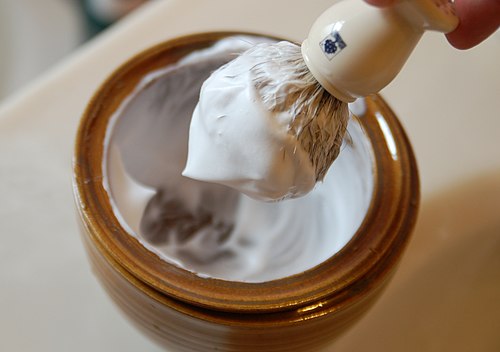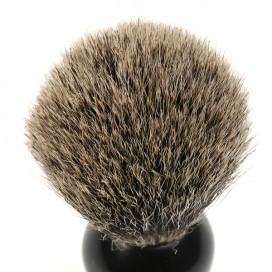
Leg shaving is the practice of removing leg hair by shaving the hair off using a razor or electric shaver. In addition, some people remove leg hair using waxing, sugaring, depilatories, epilators or other depilation devices, or lasers, but shaving remains the least expensive and one of the least painful methods.

The toothbrush is an oral hygiene instrument used to clean the teeth, gums, and tongue. It consists of a head of tightly clustered bristle, atop of which toothpaste can be applied, mounted on a handle which facilitates the cleaning of hard-to-reach areas of the mouth. They are usually used alongside floss.

A brush is a common tool with bristles, wire or other filaments. It generally consists of a handle or block to which filaments are affixed in either a parallel or perpendicular orientation, depending on the way the brush is to be gripped during use. The material of both the block and bristles or filaments is chosen to withstand hazards of its intended use, such as corrosive chemicals, heat or abrasion. It is used for cleaning, grooming hair, make up, painting, surface finishing and for many other purposes. It is one of the most basic and versatile tools in use today, and the average household may contain several dozen varieties.

A razor is a bladed tool primarily used in the removal of unwanted body hair through the act of shaving. Kinds of razors include straight razors, disposable razors, and electric razors.

A mug is a type of cup typically used for drinking hot beverages, such as coffee, hot chocolate, soup, or tea. Mugs usually have handles and hold a larger amount of fluid than other types of cup. Usually a mug holds approximately 8-12 US fluid ounces (350 ml) of liquid; double a tea cup. A mug is a less formal style of drink container and is not usually used in formal place settings, where a teacup or coffee cup is preferred. Shaving mugs are used to assist in wet shaving.
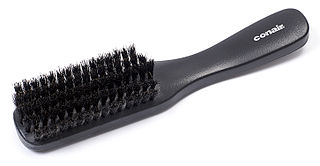
A hairbrush is a stick brush with rigid or soft spokes used in hair care for smoothing, styling, and detangling human hair, or for grooming an animal's fur. It can also be used for styling in combination with a curling iron or hair dryer.
Gillette is an American brand of safety razors and other personal care products including shaving supplies, owned by the multi-national corporation Procter & Gamble (P&G).
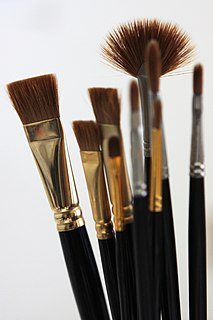
A kolinsky sable-hair brush is a fine artists' paintbrush.

The electric razor is a razor with a rotating or oscillating blade. The electric razor usually does not require the use of shaving cream, soap, or water. The razor may be powered by a small DC motor, which is either powered by batteries or mains electricity. Many modern ones are powered using rechargeable batteries. Alternatively, an electro-mechanical oscillator driven by an AC-energized solenoid may be used. Some very early mechanical shavers had no electric motor and had to be powered by hand, for example by pulling a cord to drive a flywheel.

A straight razor is a razor with a blade that can fold into its handle. They are also called open razors and cut-throat razors. The predecessors of the modern straight razors include bronze razors, with cutting edges and fixed handles, produced by craftsmen from Ancient Egypt during the New Kingdom. Solid gold and copper razors were also found in Ancient Egyptian tombs dating back to the 4th millennium BC.

Schick is a brand of personal care and safety razors owned by Edgewell Personal Care. The company was founded in 1926 and was purchased by Energizer in 2003 from Pfizer. On July 1, 2015, Energizer split into two companies with Schick falling under Edgewell Personal Care.

Ingrown hair is a condition where a hair curls back or grows sideways into the skin. The condition is most prevalent among people who have coarse or curly hair. It may or may not be accompanied by an infection of the hair follicle (folliculitis) or "razor bumps", which vary in size. While ingrown hair most commonly appears in areas where the skin is shaved or waxed, it can appear anywhere. Anything which causes the hair to be broken off unevenly with a sharp tip can cause ingrown hairs. Ingrown hairs are also caused because of lack of natural exfoliation in the skin.

Judaism prohibits shaving with a razor on the basis of a rabbinic interpretation of Leviticus 19:27, which states, "You shall not round off the side-growth on your head, or destroy the side-growth of your beard." The Mishnah interprets this as a prohibition on using a razor on the beard. This prohibition is further expanded upon in kabbalistic literature. The halakhic prohibition applies to shaving off the pe'ot (sidelocks) and corners of the beard by means of a razor.
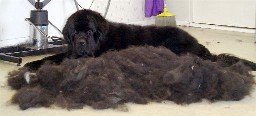
Dog grooming refers to both the hygienic care and cleaning of a dog, as well as a process by which a dog's physical appearance is enhanced for showing or other types of competition. A dog groomer is a person who earns their living grooming dogs.
Taklon is the common name for a synthetic fiber used in artist-quality paint, makeup and pin stripe brushes. It is a smooth, soft, and somewhat fragile polyester derivative devoid of any protein component or allergen elements and is therefore used in the cosmetic industries as a "green," "vegan," "allergy free" or synthetic alternative to animal hair brushes.

A makeup brush is a tool with bristles, used for the application of makeup or face painting. The bristles may be made out of natural or synthetic materials, while the handle is usually made out of plastic or wood. When cosmetics are applied using the appropriate brush, they blend better into the skin.

A paintbrush is a brush used to apply paint or sometimes ink. A paintbrush is usually made by clamping the bristles to a handle with a ferrule. They are available in various sizes, shapes, and materials. Thicker ones are used for filling in, and thinner ones are used for details. They may be subdivided into decorators' brushes used for painting and decorating and artists' brushes use for visual art.











